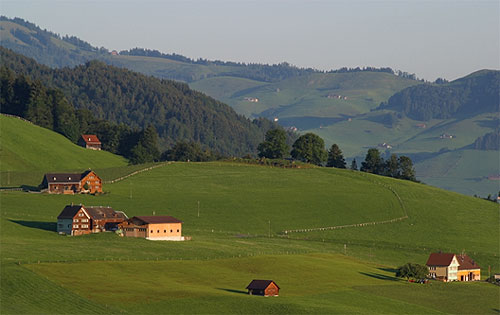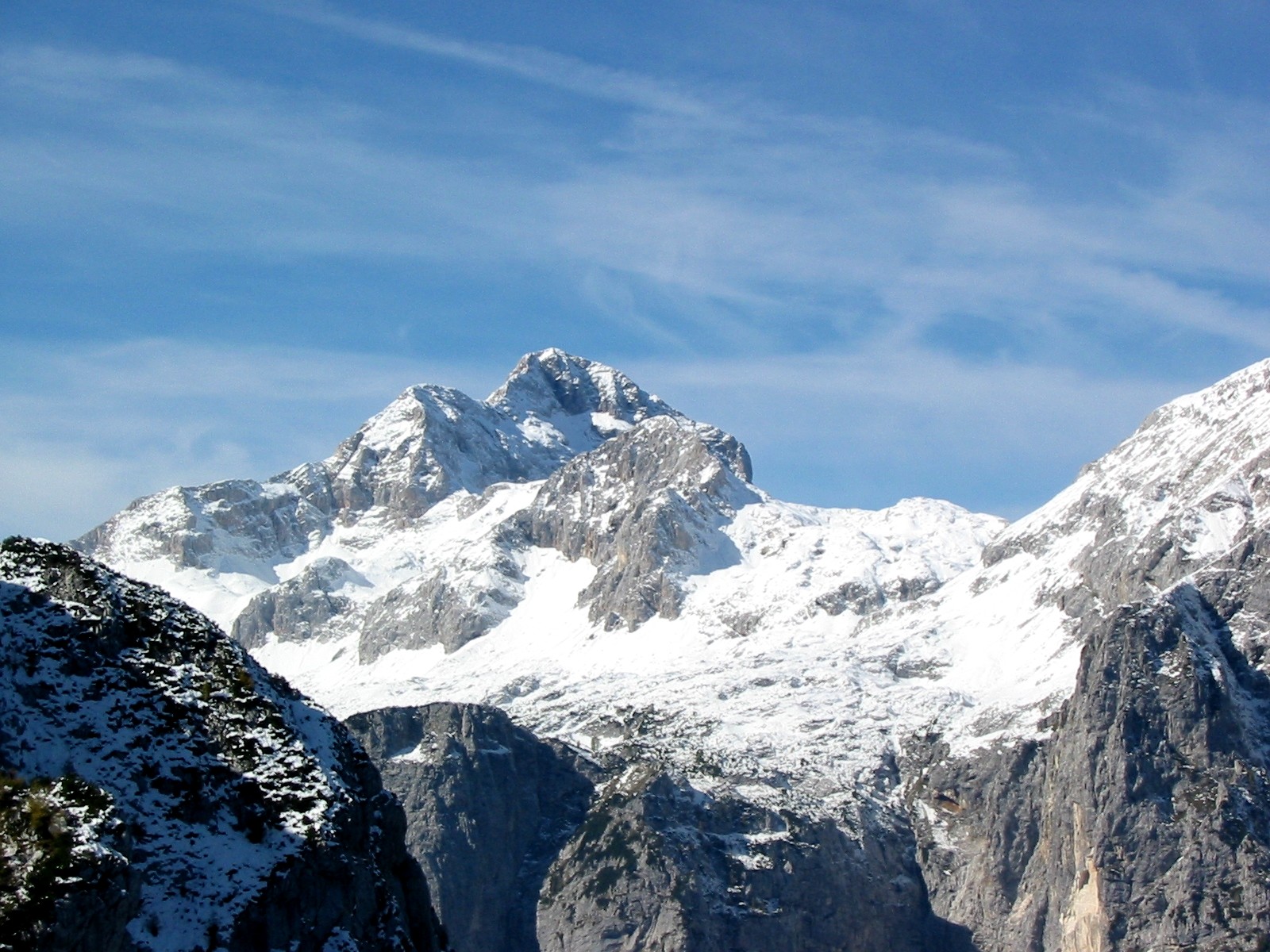|
Bavšica
Bavšica (; ) is a dispersed settlement in the Municipality of Bovec in the Littoral region of Slovenia. Geography Bavšica lies in a glacial valley below Mount Bavšica Grintovec () in the Julian Alps The Julian Alps (, , , , ) are a mountain range of the Southern Limestone Alps that stretches from northeastern Italy to Slovenia, where they rise to 2,864 m at Mount Triglav, the highest peak in Slovenia. A large part of the Julian Alps is inclu ... to the east and the Log Cliff (, ) to the north. The valley also hosts the Bavšica Hiking Training Center () (PUS Bavšica), the main educational center of the Alpine Association of Slovenia. Name Bavšica was attested in written sources in 1763–87 as ''Bauschiza''. The name is derived from the Slovene common noun ''balha'' (dialect ''baha'') ' matgrass', referring to the local vegetation. A less likely explanation is that the name is derived from the adjective ''*balh'' 'whitish, pale'. References External links Bavšica on Ge ... [...More Info...] [...Related Items...] OR: [Wikipedia] [Google] [Baidu] |
Municipality Of Bovec
The Municipality of Bovec ( or ; ) is a municipality in northwestern Slovenia. Its center is the town of Bovec. , its mayor is Valter Mlekuž. Geography The northern parts of the municipality up the Trenta Valley to the peaks of Mts. Mangart, Jalovec, and Triglav are located within Triglav National Park, but not Bovec itself. Two of the most important mountain passes in the Julian Alps are located in the Municipality of Bovec: the Predil Pass on the border between Slovenia and Italy in the northwest, and the Vršič Pass in the northeast, which connects the Soča Valley to Kranjska Gora in the neighbouring Slovenian region of Upper Carniola. In the southwest the Učja (Uccea) Pass connects Bovec with the Resia Valley in Italy. Settlements In addition to the municipal seat of Bovec, the municipality also includes the following settlements: * Bavšica * Čezsoča * Kal–Koritnica * Lepena * Log Čezsoški * Log pod Mangartom * Plužna * Soča * Srpenica * Strmec na Prede ... [...More Info...] [...Related Items...] OR: [Wikipedia] [Google] [Baidu] |
Flag Of Slovenia
The national flag of Slovenia () features three equal horizontal bands of white (top), blue, and red, with the coat of arms of Slovenia located in the upper hoist side of the flag centred in the white and blue bands. The coat of arms is a shield with the image of Mount Triglav, Slovenia's highest peak, in white against a blue background at the centre; beneath it are two wavy blue lines representing the Adriatic Sea and local rivers, and above it are three six-pointed golden stars arranged in an inverted triangle which are taken from the coat of arms of the Counts of Celje, the great Slovene dynastic house of the late 14th and early 15th centuries. The Slovenian flag's colours are considered to be Pan-Slavism, pan-Slavic, but they actually come from the Middle Ages, medieval coat of arms of the Holy Roman duchy of Carniola, consisting of 3 stars, a mountain, and three colours (red, blue, yellow), crescent. The existing Slovene tricolor, Slovene tricolour was raised for the first t ... [...More Info...] [...Related Items...] OR: [Wikipedia] [Google] [Baidu] |
Slovenia
Slovenia, officially the Republic of Slovenia, is a country in Central Europe. It borders Italy to the west, Austria to the north, Hungary to the northeast, Croatia to the south and southeast, and a short (46.6 km) coastline within the Adriatic Sea to the southwest, which is part of the Mediterranean Sea. Slovenia is mostly mountainous and forested, covers , and has a population of approximately 2.1 million people. Slovene language, Slovene is the official language. Slovenia has a predominantly temperate continental climate, with the exception of the Slovene Littoral and the Julian Alps. Ljubljana, the capital and List of cities and towns in Slovenia, largest city of Slovenia, is geographically situated near the centre of the country. Other larger urban centers are Maribor, Ptuj, Kranj, Celje, and Koper. Slovenia's territory has been part of many different states: the Byzantine Empire, the Carolingian Empire, the Holy Roman Empire, the Kingdom of Hungary, the Republic of Venice ... [...More Info...] [...Related Items...] OR: [Wikipedia] [Google] [Baidu] |
Slovenian Littoral
The Slovene Littoral, or simply Littoral (, ; ; ), is one of the traditional regions of Slovenia. The littoral in its name – for a coastal-adjacent area – recalls the former Austrian Littoral (''Avstrijsko Primorje''), the Habsburg possessions on the upper Adriatic coast, of which the Slovene Littoral was part. Today, the Littoral is often associated with the Slovenian ethnic territory that, in the first half of the 20th century, found itself in Italy to the west of the Rapallo Border, which separated a quarter of Slovenes from the rest of the nation, and was strongly influenced by Italian fascism. Geography The region forms the westernmost part of Slovenia, bordering the inter-municipal union of Giuliana in the region of Friuli-Venezia Giulia of Italy. It stretches from the Adriatic Sea in the south up to the Julian Alps in the north. The Slovene Littoral comprises two traditional provinces: Goriška and Slovene Istria. The Goriška region takes its name from th ... [...More Info...] [...Related Items...] OR: [Wikipedia] [Google] [Baidu] |
Statistical Regions Of Slovenia
The statistical regions of Slovenia are 12 administrative entities created in 2000 for legal and statistical purposes. Division By a decree in 2000, Slovenia has been divided into 12 statistical regions (Nomenclature of Territorial Units for Statistics, NUTS-3 level), which are grouped in two cohesion regions (NUTS-2 level). The statistical regions have been grouped into two cohesion regions are: *Eastern Slovenia (''Vzhodna Slovenija'' – SI01), which groups the Mura, Drava, Carinthia, Savinja, Central Sava, Lower Sava, Southeast Slovenia, and Littoral–Inner Carniola regions. *Western Slovenia (''Zahodna Slovenija'' – SI02), which groups the Central Slovenia, Upper Carniola, Gorizia, and Coastal–Karst regions. Sources Slovenian regions in figures 2014 See also *List of Slovenian regions by Human Development Index *Municipalities of Slovenia *Traditional regions of Slovenia References External links Regions Stat.si (accessed 15 December 2020). Map of st ... [...More Info...] [...Related Items...] OR: [Wikipedia] [Google] [Baidu] |
Gorizia Statistical Region
The Gorizia Statistical Region () is a statistical region in western Slovenia, along the border with Italy. It is named after the Italian town of Gorizia (the feminine adjective ''goriška'' comes from the Slovenian name for Gorizia: ''Gorica''). The Julian Alps, the Soča River, and the Vipava Valley are the most prominent natural features of this region. It contributed just over 5% to total national GDP in 2012, but in terms of GDP per capita it ranked fourth in the country. In the same year, disposable income per capita in the region the highest, in second place behind the Central Slovenia Statistical Region. Housing stock estimates indicate that at the end of 2013 the region had the highest share of dwellings with three or more rooms (around 70%). The share of single-room dwellings was less than 10%. Dwellings here are larger than the Slovenian average, with 37 m2 of usable floor space per person on average. The number of cars per 1,000 population is also the highest in Slov ... [...More Info...] [...Related Items...] OR: [Wikipedia] [Google] [Baidu] |
Municipalities Of Slovenia
Slovenia is divided into 212 municipalities (Slovene language, Slovene: ''občine'', singular''občina''), of which 12 have urban (metropolitan) status. Municipalities are further divided into local communities and districts. Slovenia has the largest number of first-level administrative divisions of any country. The municipalities vary considerably in size and population, from the capital Ljubljana with more than 280,000 inhabitants to Hodoš with fewer than 400. Urban status is not granted strictly on the basis of population; the smallest urban municipality, Urban Municipality of Slovenj Gradec, Slovenj Gradec, has less than half as many inhabitants as the most populous non-urban municipality, Municipality of Domžale, Domžale. Slovene language, Slovene is the official language in all municipalities. Hungarian language, Hungarian is the second official language of three municipalities in Prekmurje: Dobrovnik/Dobronak, Hodoš/Hodos, and Lendava/Lendva. Italian language, Italian ... [...More Info...] [...Related Items...] OR: [Wikipedia] [Google] [Baidu] |
Dispersed Settlement
A dispersed settlement, also known as a scattered settlement, is one of the main types of settlement patterns used by landscape historians to classify rural settlements found in England and other parts of the world. Typically, there are a number of separate farmsteads scattered throughout the area. A dispersed settlement contrasts with a nucleated village. The French term '' bocage'' is sometimes used to describe the type of landscape found where dispersed settlements are common. In addition to Western Europe, dispersed patterns of settlement are found in parts of Papua New Guinea, as among the Gainj, Ankave, and Baining tribes. It is also frequently met with in nomadic pastoral societies. In Ghana, Kumbyili in the northern region is also an example of a dispersed settlement England In England, dispersed settlements are often found in the areas of ancient enclosure outside the central region—for example, Essex, Kent and the West Country. An example of a dispersed settlemen ... [...More Info...] [...Related Items...] OR: [Wikipedia] [Google] [Baidu] |
Glacial Valley
U-shaped valleys, also called trough valleys or glacial troughs, are formed by the process of glaciation. They are characteristic of mountain glaciation in particular. They have a characteristic U shape in cross-section, with steep, straight sides and a flat or rounded bottom (by contrast, valleys carved by rivers tend to be V-shaped in cross-section). Glaciated valleys are formed when a glacier travels across and down a slope, carving the valley by the action of scouring. When the ice recedes or thaws, the valley remains, often littered with small boulders that were transported within the ice, called glacial till or glacial erratic. Examples of U-shaped valleys are found in mountainous regions throughout the world including the Andes, Alps, Caucasus Mountains, Himalaya, Rocky Mountains, New Zealand and the Scandinavian Mountains. They are found also in other major European mountains including the Carpathian Mountains, the Pyrenees, the Rila and Pirin mountains in Bulgari ... [...More Info...] [...Related Items...] OR: [Wikipedia] [Google] [Baidu] |
Julian Alps
The Julian Alps (, , , , ) are a mountain range of the Southern Limestone Alps that stretches from northeastern Italy to Slovenia, where they rise to 2,864 m at Mount Triglav, the highest peak in Slovenia. A large part of the Julian Alps is included in Triglav National Park. The second highest peak of the range, the 2,755 m high Jôf di Montasio, lies in Italy. The Julian Alps cover an estimated 4,400 km2 (of which 1,542 km2 lies in Italy). They are located between the Sava Valley and Canale Valley. They are divided into the Eastern and Western Julian Alps. Name The Julian Alps were known in antiquity as ''Alpes Iuliae'', and also attested as ''Alpes Julianae'' AD 670, ''Alpis Julia'' 734, and ''Alpes Iulias'' in 1090. Like the municipium of ''Forum Julii'' (now Cividale del Friuli) at the foot of the mountains, the range was named after Julius Caesar of the gens Julia, perhaps due to a road built by Julius Caesar and completed by Augustus. Eastern Julian A ... [...More Info...] [...Related Items...] OR: [Wikipedia] [Google] [Baidu] |
Nardus Stricta
''Nardus'' is a genus of plants belonging to the grass family, containing the single species ''Nardus stricta'', known as matgrass. It is placed in its own tribe Nardeae within the subfamily Pooideae. The name derives from ancient Greek ' () from the earlier Akkadian ''lardu''. It is not to be confused with spikenard, '' Nardostachys jatamansi''. Distribution and ecology ''Nardus stricta'' is native to Eurasia (from Iceland and the Azores to Mongolia), North Africa (Algeria, Morocco), and northeastern North America (Greenland, eastern Canada, and the northeastern United States). ''Nardus stricta'' occurs on heath, moorland, hills, and mountains on nutrient poor acidic sandy to peaty soils and is strongly calcifuge, avoiding calcareous soils. It can occur from low elevations to over , becoming a community-dominant in late snow patches on mountains. ''Nardus stricta'' may also become a dominant species in habitats grazed by cattle or sheep because it is tough and unpalatable. I ... [...More Info...] [...Related Items...] OR: [Wikipedia] [Google] [Baidu] |





